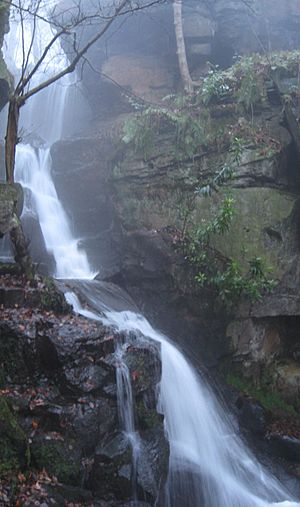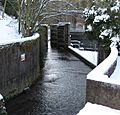Bentley Brook facts for kids
Quick facts for kids Bentley Brook |
|
|---|---|

Bridge carrying Oaksedge Lane over Bentley Brook as it enters the reservoir
|
|
| Country | England |
| Region | Derbyshire |
| Physical characteristics | |
| Main source | Matlock Moor, England |
| River mouth | Derbyshire, England |
Bentley Brook is a small but important stream in Derbyshire, England. It starts on Matlock Moor and flows south. This stream passes through Cuckoostone Dale and into Lumsdale. It collects water from other smaller streams, like Knabhall Brook. Knabhall Brook itself is dammed and helps power large mills. Bentley Brook then flows into an old mill pond and over a waterfall. It passes several historic mill ruins. Finally, it joins the River Derwent near Matlock. Even though it's only about five miles long, the Environment Agency considers Bentley Brook a 'main river'.
Contents
The Story of Lumsdale Mills
Bentley Brook, once known as "Lums," flows through the beautiful, wooded Lumsdale Valley. This valley is famous for its old water wheels and mill ponds. It holds some of the best examples of early water power use in Great Britain. For centuries, the stream's power was used by many mills in the valley.
Bone Mill: Grinding Bones for Farms
One of the oldest mills is Bone Mill. It dates back to the 1500s. This mill was used to grind animal bones into fertiliser for farms. It worked until the 1920s. You can still see where its water wheel was and the channel that carried water back to Bentley Brook.
Lower Dam and the Second Mill
Past some old cottages and a footbridge, you'll find a pretty pond. This pond is held by the Lower Dam, built in 1830. It was made to collect water from the Brook. A metal pipe from the dam wall carried water to the second mill. This mill, built around 1850, was still a sawmill in the early 1900s. Nearby, you can spot a large millstone. It came all the way from France and was originally made of six pieces held together with iron.
Paint Mill and Other Uses
As you follow the path, you'll come to "Paint Mill." The Arkwright Society has helped preserve this mill. It was mainly used to grind white barytes, a mineral used in paint. This mill also helped smelt lead, grind corn, and bleach materials.
The Fourth Mill and Waterfalls
The fourth mill is right next to the Brook's biggest waterfall. It was built in the 1770s. This mill was used to grind corn and other minerals. The power of Bentley Brook has created impressive waterfalls from the limestone rock.
Bleaching and Cotton Mills
Below the waterfalls, you'll find the fifth mill, called Upper Bleach Mill. You can still see parts of its bleaching vats. This mill was connected to the last one, Garton Mill, by a clever train system. This system moved heavy loads of cotton between them.
Garton Mill is the largest and best-preserved of the six mills. It was built around 1785 for spinning cotton. Even though the valley's water system was changed to help it, this mill wasn't very successful at first. The company went out of business by 1813. Later, John Garton bought the valley. He changed the mill completely for bleaching. It continued to work as a textile finishing mill into the early 1900s.
The Power of the Brook
Bentley Brook is usually a gentle stream. But it can become a powerful torrent during heavy rains. In December 1965, heavy rain caused major flooding in Derbyshire. This shows how strong nature can be. Even so, this small stream has been very useful. It powered many mills, providing jobs and helping people for centuries.
Images for kids












